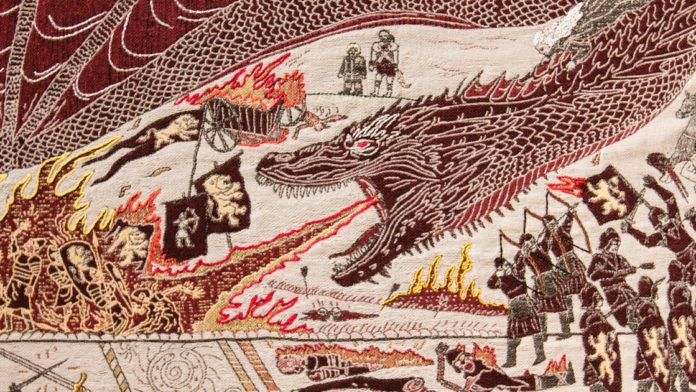While the rest of us were reeling from the season finale of Game of Thrones, an army of designers, embroiderers, and seamstresses in Northern Ireland was hard at work. The most pivotal scene of the episode, you see, involved a dragon. But not just any dragon. It was Viserion, the Night King’s dragon, which spewed ice so cold it could burn. And regular dragons were already the hardest characters to sew on their 253-foot tapestry of every single episode of Game of Thrones ever made—let alone an ice dragon who just blew up a wall at the end of the earth.
Yes, you did read that right. Every season. Every episode. Every epic moment, from Ned’s beheading, to the Red Wedding, to the fall of the wall, is meticulously stitched with bespoke thread on giant linen tapestry. It hangs in Belfast’s Ulster Museum, open to the public from 10 a.m. to 5 p.m every day, except for bank holidays.
Belfast is the unofficial center of the Game of Thrones universe: Not only does the area double for The North, but it’s the home of Titanic Studios, the show’s production studios. This newfound visibility caused a tourism boom—a “Game of Thrones effect,” if you will—which has seen a flood of jet-setters to Belfast since the show aired in 2011.
The city responded in kind, hosting themed tours of “The North,” gift shops with Game of Thrones souvenirs, and a Winterfell Festival at Castle Ward and the real-life location of the Stark compound. And now, a massive, ornate tapestry.
Why a tapestry? “We are always looking for more opportunities to experience the story of Game of Thrones in different ways. We looked to Northern Ireland’s past for inspiration in ways of retelling the story,” Brian Twomey, Tourism Ireland’s head of marketing communications, tells Vogue.
Northern Ireland has a rich history of textile manufacturing. It dates back 2,000 years, and during the Industrial Revolution, linen was the region’s top product. So it made sense to combine Northern Ireland’s old economic stalwart with one of its new ones.
Tourism Ireland put the idea into production this year. It took three months for the seamstresses to create all the episodes up to Season 7, but since they started sewing on an episode-to-episode basis, each episode has taken seven days in total: a few days for design, another day for the actual weaving process using a state-of-the-art Jacquard loom, and another two days for all the hand-finishing and embroidery.
The hand-finishing took so long because, this being Game of Thrones, everything is grand and over-the-top. Dragons, as mentioned, are the most difficult to finish—“the sheer scale, majesty, and color mix is incredibly visually arresting,” Twomey says—but human characters presented certain challenges, too. “Daenerys has her own specific white gold hair color threads stitched on, so she probably receives slightly more attention from the embroidery team compared with the other characters.” The attention to hair detail is paramount: Viewers know that although Cersei and Daenerys both have blonde hair, Lannister blonde is very, very different from Targaryen blonde.
But it’s not just hair—it’s everything. It’s stitching precious-metal colors like silver and gold into crowns and battle armor to add grandeur, getting the ghoulish green for wildfire just right, portraying emotions like fear and jealousy and sadness and lust. It’s a lot—and there’s a lot to lose if a mistake is made. If Game of Thrones fans are anything, it’s passionate. But the artisans have been dauntless, “fueled by tea and biscuits,” Twomey says. Every time, they managed to hang a completed panel right before the next episode aired. They’re on a break now, but come next season, it will be back to the drawing board to do it all—dragons, deaths, battles, and blowups—again.




















![[Book Review] The Blade Itself (The First Law Trilogy) by Joe Abercrombie](https://bendthekneegot.com/wp-content/uploads/2018/01/1516047103_maxresdefault-218x150.jpg)

















